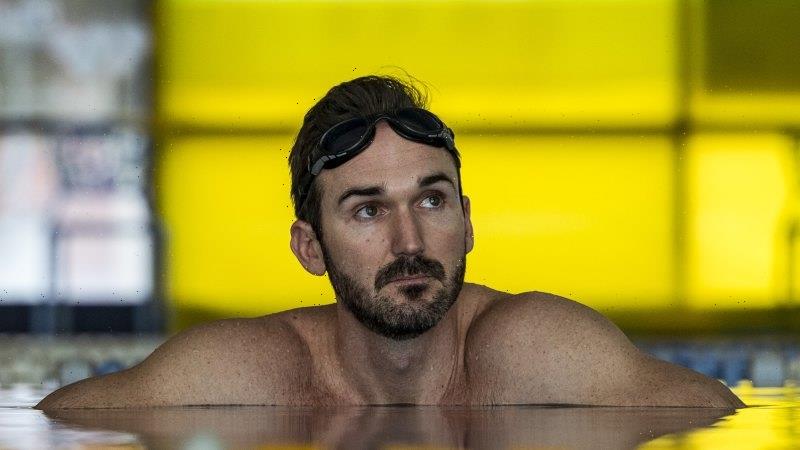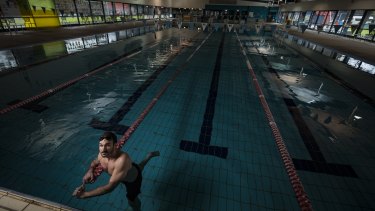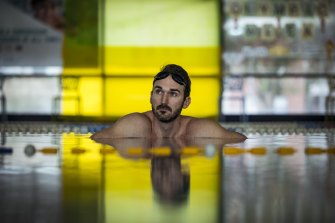A shortage of swimming instructors is preventing the teaching of crucial water safety skills to thousands of Victorian children.
Life Saving Victoria figures show there is a shortage of 1800 instructors across the state and swim schools say they cannot find enough trained staff to meet demand for lessons.
And as the nation celebrates the medal-winning feats of Australia’s Olympic swimmers in Tokyo, Life Saving Victoria hopes more people will consider becoming swim instructors.
The push for greater water safety awareness comes after 59 people drowned in Victoria in the past financial year, the highest death toll in more than 20 years.
Kensington Community Recreation Centre manager David Rowe needs another 10 swimming teachers to meet demand at his pool. Credit:Chris Hopkins
Life Saving Victoria hopes a career in swimming instruction will appeal to parents and older adults. Pay rates typically start at $28 for a casual instructor during the week with loadings on weekends and higher rates for more qualified teachers.
The organisation’s chief executive, Catherine Greaves, said the findings of an online survey of 39 swim schools suggested that instructor qualification and licence renewal costs may be contributing to the shortage.
“The aquatics industry has been aware of the swim teacher shortage for some time, but until now, the full extent of it has not been known,” she said.
“This is why Life Saving Victoria has conducted this research, so that we know where we currently stand and to help inform solutions to address this issue.”
Research from Life Saving Victoria has found there is a shortage of 1800 swimming instructors across the state. Credit:Justin McManus
The survey, conducted in May this year, found there was a 23.8 per cent fall in the number of swimming teachers employed between 2019 and 2021.
Life Saving Victoria estimates that 145,000 swimming lessons are missed each week Victoria is in lockdown, not including classes run through primary schools.
YMCA Victoria and Kingswim chief executive Carolyn Morris said there had only been six weeks of continuous swimming lessons for children over the past 18 months due to lockdowns, restrictions and school holidays.
Ms Morris said there was extremely high demand for swimming lessons but industry-wide teacher shortages had resulted in young people moving into other industries that were allowed to stay open during the pandemic. The YMCA would normally employ about 800 swim teachers but currently has only about 650.
Children were at risk of falling behind on “benchmark competencies”, she warned.
“And with the Olympics in full swing, it’s timely to look further ahead and think about where our next generation of champions might come from,” she said.
Kensington Community Recreation Centre manager David Rowe. Credit:Chris Hopkins
Kensington Community Recreation Centre manager David Rowe said demand was very strong for swimming lessons outside of lockdowns, with the centre running up to 33 classes a day during the week and 88 classes on weekends in busy periods.
But he said the centre, soon to undergo redevelopment, needed 10 more swimming teachers to meet demand, in addition to the 28 instructors currently on the books.
Mr Rowe said children’s swimming skills could fall away quickly even with short absences from the pool.
“We always advocate swimming through [the year],” he said. “Even taking winter off, kids can go from quite a high level back to a lower class.”
Life Saving Victoria offers swimming teacher training courses but becoming a qualified infant swim instructor requires additional training.
Mr Rowe said there was a particularly acute shortage in qualified instructors for very young children.
The state endured a horrific summer of drownings, prompting Life Saving Victoria to call for its patrol period to be permanently extended as Victorians made millions of visits to beaches on the coastline and in the bays.
La Trobe University associate professor of physiotherapy Christian Barton said it was not yet clear what impact the pandemic would have on pathways into elite sport.
But he said lockdowns would have broader consequences, particularly for community sport. “Most of sport should be about participation and community,” he said. “That’s the biggest loss from the pandemic – missing out on those social connections.”
Life Saving Victoria cited Royal Life Saving Australia figures that the aquatics industry in Victoria employed about 20,000 workers including swim teachers, lifeguards and administrative staff.
Education Minister James Merlino said swimming teachers were mostly employed privately, but the state government’s “swimming in schools initiative” meant all children would have the chance to learn to swim.
“We know water safety and swimming lessons are a crucial part of Australian kids’ education – and we’re working to make sure no kids miss out on that opportunity due to the pandemic,” Mr Merlino said.
The Morning Edition newsletter is our guide to the day’s most important and interesting stories, analysis and insights. Sign up here.
Most Viewed in National
From our partners
Source: Read Full Article



